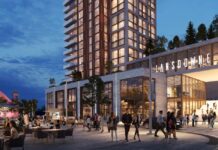Development charges biggest issue affecting industry – possible massive fee increase imminent
By Mark Buckshon
Ottawa Construction Newsstaff writer
Josh Kardish, the Greater Ottawa Home Builders’ Association (GOHBA) new Builder/Developer Council (BDC) chair, has some major imminent and longer-range challenges as homebuilders and municipal officials and politicians set out their positions on crucial issues, including the always-contentious municipal development charges.
Kardish, at 36, works with other voluntary BDC members in reviewing and responding to often arcane but vital issues at the GOHBA’s foundation: Official Plan amendments, municipal infill and zoning bylaw issues and other topics that sometimes seem to (almost literally) fly in from left field – such as endangered species and migratory bird regulations.
“I want to continue to learn about all these issues,” Kardish said at his Regional Group offices, where he works as manager, land development. “I appreciate all the people including the senior members of GOHBA, the solicitors and consultants who volunteer their time on behalf of the organization.”
The biggest concern: A possible massive increase in development charges, as the city seeks to fund the LRT project and major sewer infrastructure projects. “We’re quite nervous that the charges could (almost) double,” he said. “They’re $24,000 to $27,000 now – we believe the charges could increase from $10,000 to $20,000 – resulting in an increase to $35,000 to $45,000.”
Kardish says builders accept that development charges are part of the cost of doing business, and a reasonable increase can be justified, allowing for inflation, and to fund infrastructure to serve new communities.
The conflict arises, however, when municipal politicians and officials seek to justify charges for services that primarily benefit existing communities/ratepayers, or use accounting devices or other methods to load up additional charges without really requiring the funds for the development process.
“We’re concerned that the increase the city is seeking in part is intended to fund a massive investment in the city’s water system,” Kardish said. “But this investment would only occur in the last two years of the development charge period, which concludes in 2031. They are thinking of investing in that infrastructure in 2029. Why are they putting it into the bylaw now, and not closer to when the city needs the funds?”
A similar, but even more imminent, challenge relates to differences in perception about how the LRT expansion should be funded. The homebuilding industry believes that the LRT will primarily benefit existing homeowners and communities, with perhaps 25 per cent reflecting growth (and thus appropriate for development charges.) The city, however, believes that current ratepayers will only benefit by one-third of the LRT expansion costs, and attributes two-thirds to growth.
The LRT and water treatment facilities are the biggest causes for development charge increases, but there are plenty of other smaller issues, such as “refurbishment of community centres in the older parts of Nepean” that would seem to have little to do with municipal growth and more to maintaining services and facilities for existing ratepayers.
BDC members are gathering and analyzing data and are hopeful they’ll be able to show municipal officials that the correct development charges levels would be on the lower end of the spectrum. A major gap almost certainly invites an appeal to the Ontario Municipal Board.
Development charges are always a contentious issue because they are relatively easy to market politically. Homebuilders and developers don’t have many votes, and existing homeowners, in addition to saving on taxes, benefit from higher land prices and property values. Of course, the real cost ultimately (and unfairly) falls on new home purchasers, when the costs are passed through to them.
Municipalities have been lobbying for other changes to development charges legislation, including provisions that would allow them to levy charges based on future rather than historical needs, and claim higher shares from new developments for hospitals, parks and other municipal services that could benefit existing and well as new homeowners.
In other matters, the BDC is working on issues relating to infill developments and official plan amendments, including concerns that Ottawa’s five year official plan – currently under review by the Ministry of Municipal Affairs – is setting standards and rules that are more appropriately covered by zoning bylaws.
These provisions, which would set out hight and building type restrictions, could straightjacket innovative development opportunities and not allow the city to effectively adapt innovative ideas into community infill projects, he indicates.
Kardish, who previously worked with a municipality in developing plans, says he appreciates the challenges municipal officials experience in their responsibilities.
“I think it would be great in my role at the BDC if we could improve relations with our regulators,” he said. “I view the city staff as being a critical part of our job. They are the regulators that implement the rules and policies that are approved by the council, representing the will of the voters. If in any way over the course of the next two years (as BDC chair) we can improve these relationships, then that’s a good thing.”
“I would like it if the development charge amendment process comes to a resolution that is happy for both the industry and city and does not involve an OMB hearing. It would be great to come to terms with the city on how to fund the infrastructure for growth and not be in a fight to do it.”







